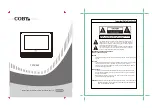
Page 16 — English
WARNING
:
When servicing, use only identical replacement parts. Use
of any other parts could create a hazard or cause product
damage.
Only the parts shown on the parts list are intended to be repaired
or replaced by the customer. All other parts should be replaced
at an authorized service center.
GENERAL MAINTENANCE
Keep the generator in a clean and dry environment where it is
not exposed to dust, dirt, moisture, or corrosive vapors. Do not
allow the cooling air slots in the generator to become clogged
with foreign material such as leaves, etc.
Do not use a garden hose to clean the generator. Water enter-
ing the fuel system or other internal parts of the unit can cause
problems that will decrease the life of the generator.
To clean the unit:
Use a soft bristle brush and/or vacuum cleaner to loosen
and remove dirt and debris.
Clean air vents with low pressure air that does not exceed
25 psi.
Wipe the exterior surfaces of the generator with a damp
cloth.
CHECKING/CLEANING AIR FILTER
See Figure 15.
For proper performance and long life, keep air filter clean.
Release latches on side of air filter cover. Remove cover and
set aside.
Remove the filter element.
If the filter element is dirty, clean with warm, soapy water.
Rinse and let dry.
Apply a light coat of engine lubricant to the element, then
squeeze it out.
Replace the element in the air filter unit.
Replace the air filter cover and latch to secure.
NOTE
: Do not run the generator without the air filter. Rapid
engine wear will result.
CHANGING ENGINE LUBRICANT
See Figure 16.
Remove the oil cap/dipstick.
Place a container underneath the oil drain plug to collect
used lubricant as it drains.
Unscrew the oil drain plug and remove.
Allow lubricant to drain completely.
NOTE:
Drain the lubricant while the engine is still warm but
not hot. Warm lubricant will drain quickly and more com-
pletely.
WARNING
:
Do not change engine lubricant while it is hot. Accidental
contact with hot engine lubricant could result in serious burns.
Reinstall the oil drain plug and tighten securely.
Refill with lubricant following the instructions in the
Checking/
Adding Lubricant
section. For amount of lubricant needed
to refill, see
Product Specifications
earlier in this manual
or the accompanying engine manual, if applicable.
Reinstall the oil cap/dipstick.
NOTE
: Used lubricant should be disposed of at an approved
disposal site. See your local oil retailer for more information.
SPARK PLUG MAINTENANCE
See Figure 17.
The spark plug must be properly gapped and free of deposits
in order to ensure proper engine operation. To check:
Remove the spark plug cap.
Clean any dirt from around base of spark plug.
Remove spark plug using wrench (not included).
Inspect spark plug for damage, and clean with a wire brush
(not included) before reinstalling. If insulator is cracked or
chipped, spark plug should be replaced. For replacement
spark plug, see
Product Specifications
earlier in this manual
or the accompanying engine manual, if applicable.
Measure plug gap. The correct gap is 0.028−0.031 in.
(0.7-0.8 mm). To widen gap, if necessary, carefully bend the
ground (top) electrode. To lessen gap, gently tap ground
electrode on a hard surface.
Seat spark plug in position; thread in by hand to prevent
cross-threading.
Tighten with wrench to compress washer. If spark plug is
new, use 1/2 turn to compress washer appropriate amount. If
reusing old spark plug, use 1/8 to 1/4 turn for proper washer
compression.
NOTE
: An improperly tightened spark plug will become very
hot and could damage the engine.
SPARK ARRESTOR
See Figure 18.
Inspect the spark arrestor for breaks or holes. Re-
place if necessary. To purchase a replacement spark
arrestor contact Powerstroke customer service at
1-877-617-3501.
Use a brush (not provided) to remove carbon deposits from
the spark arrestor screen as needed.
DRAINING FUEL TANK/CARBURETOR
See Figures 19 - 20.
To help prevent gum deposits in the fuel system, drain the fuel
from the tank and carburetor before storing.
DRAINING THE FUEL TANK
Turn the engine switch
OFF ( O )
.
Turn the fuel valve to the
OFF
position.
Remove the fuel line from the petcock by squeezing the ends
of the retaining clip and sliding the fuel line off.
Install one end of a drain line over the petcock, and place
the other end in a fuel container large enough to catch the
fuel being drained from the tank.
Turn the fuel valve to the
ON
position.
MAINTENANCE
Содержание PS907000
Страница 46: ...Page Pàgina 22 NOTES NOTAS ...
















































